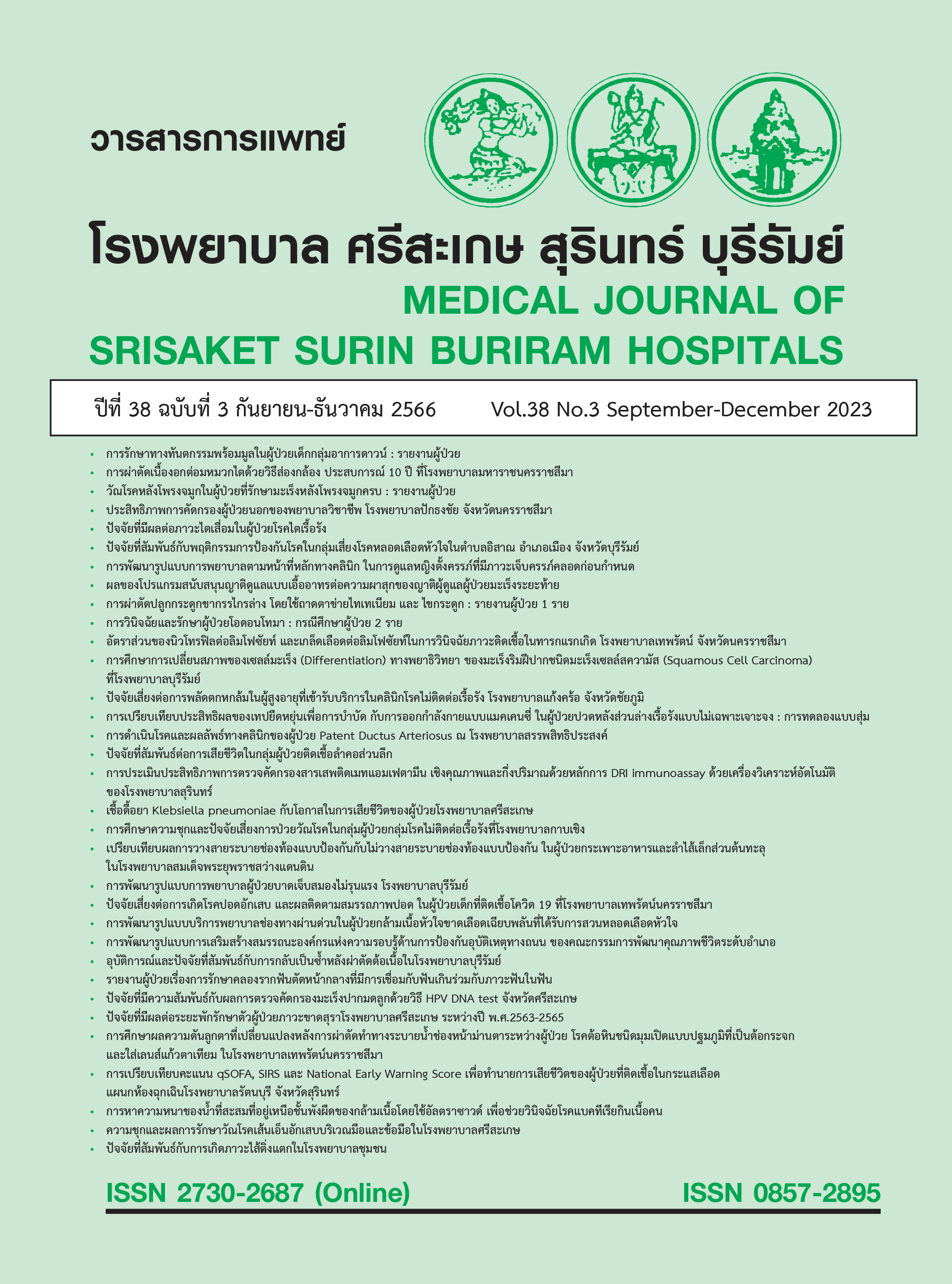การเปรียบเทียบประสิทธิผลของเทปยืดหยุ่นเพื่อการบำบัด กับการออกกำลังกายแบบแมคเคนซี่ในผู้ป่วยปวดหลังส่วนล่างเรื้อรังแบบไม่เฉพาะเจาะจง : การทดลองแบบสุ่ม
Main Article Content
บทคัดย่อ
หลักการและเหตุผล: โรคปวดหลังส่วนล่างเรื้อรังแบบไม่เฉพาะเจาะจง ทำให้เกิดภาวะทุพพลภาพในระยะยาวและ ส่งผลกระทบต่อผู้คนทั่วโลก เป้าหมายในการรักษาคือ ลดปวด และช่วยทำให้การทำกิจวัตร ประจำวันดีขึ้น การรักษามีมากมาย แต่ยังไม่มีการรักษาใดที่สามารถแก้ปัญหาได้อย่างแท้จริง
วัตถุประสงค์: เพื่อเปรียบเทียบประสิทธิผลของ Kinesiotaping (KT) กับการออกกำลังกายแบบ McKenzie ในผู้ป่วยที่มีอาการปวดหลังล่างเรื้อรังแบบไม่เฉพาะเจาะจง
วิธีการศึกษา: ผู้ป่วยปวดหลังส่วนล่าง 24 คน แบ่งออกเป็น 2 กลุ่มด้วยการสุ่ม (Randomization) ได้แก่ กลุ่ม KT (n= 12) และกลุ่ม McKenzie (n= 12) ทำการวัดระดับความปวดด้วย Numeric rating scale (NRS) และภาวะทุพพลภาพประเมินด้วย Oswestry disability index (ODI) ก่อนและหลังการทดลอง 5 วัน วิเคราะห์ข้อมูลด้วยสถิติ Independent t-test เพื่อเปรียบเทียบความแตกต่างระหว่างกลุ่ม
ผลการศึกษา: เมื่อเปรียบเทียบก่อน-หลังการรักษาเป็นระยะเวลา 5 วัน พบว่า NRS ทั้ง 2 กลุ่มไม่มีความแตกต่างกันทางสถิติ (p= 0.210) ในกลุ่ม KT มีค่าเฉลี่ยของ NRS ที่เปลี่ยนแปลง 1.25 ± 1.36 (NRS ก่อน 5.42 ± 1.88 หลัง 4.17 ± 1.59) และกลุ่ม McKenzie เปลี่ยนแปลง 0.67 ± 0.78 (NRS ก่อน 5.00 ± 1.28 หลัง 4.33 ± 1.30) แต่ ODI ในทั้ง 2 กลุ่มมีความแตกต่างอย่างมีนัยสำคัญทางสถิติ (p= 0.035) โดยพบว่าในกลุ่ม KT มีค่าเฉลี่ยของ ODI เปลี่ยนแปลง 2.09 ± 2.86 (ODI ก่อน 43.33 ± 16.99 หลัง 41.24 ± 17.08) และกลุ่ม McKenzie เปลี่ยนแปลง 0.19 ± 0.64 (ก่อน 37.17 ± 18.86 หลัง 36.98 ± 19.03)
สรุป: หลังจาก 5 วันระดับความปวดในผู้ป่วยปวดหลังส่วนล่างเรื้อรังแบบไม่เฉพาะเจาะจงลดลงทั้งในกลุ่ม KT และ McKenzie ส่วนภาวะทุพพลภาพในทั้ง 2 กลุ่มก็ลดลงเช่นกัน แต่ภาวะทุพพลภาพในกลุ่ม KT ลดลงมากกว่ากลุ่ม McKenzie
Article Details

อนุญาตภายใต้เงื่อนไข Creative Commons Attribution-NonCommercial-NoDerivatives 4.0 International License.
เอกสารอ้างอิง
GBD 2021 Low Back Pain Collaborators. Global, regional, and national burden of low back pain, 1990-2020, its attributable risk factors, and projections to 2050: a systematic analysis of the Global Burden of Disease Study 2021. Lancet Rheumatol 2023;5(6):e316-e329. doi: 10.1016/S2665-9913(23)00098-X.
Airaksinen O, Brox JI, Cedraschi C, Hildebrandt J, Klaber-Moffett J, Kovacs F, et al. Chapter 4. European guidelines for the management of chronic nonspecific low back pain. Eur Spine J 2006;15 Suppl 2(Suppl 2):S192-300. doi: 10.1007/s00586-006-1072-1.
O'Sullivan P. Diagnosis and classification of chronic low back pain disorders: maladaptive movement and motor control impairments as underlying mechanism. Man Ther 2005;10(4):242-55. doi: 10.1016/j.math.2005.07.001.
Waddell G. Subgroups within "nonspecific" low back pain. J Rheumatol 2005;32(3):395-6. PMID: 15742427
Hestbaek L, Leboeuf-Yde C, Manniche C. Low back pain: what is the long-term course? A review of studies of general patient populations. Eur Spine J 2003;12(2):149-65. doi: 10.1007/s00586-002-0508-5.
Chou R, Qaseem A, Snow V, Casey D, Cross JT Jr, Shekelle P, et al. Diagnosis and treatment of low back pain: a joint clinical practice guideline from the American College of Physicians and the American Pain Society. Ann Intern Med 2007;147(7):478-91. doi: 10.7326/0003-4819-147-7-200710020-00006.
Hammill RR, Beazell JR, Hart JM. Neuromuscular consequences of low back pain and core dysfunction. Clin Sports Med 2008;27(3):449-62, ix. doi: 10.1016/j.csm.2008.02.005.
Namnaqani FI, Mashabi AS, Yaseen KM, Alshehri MA. The effectiveness of McKenzie method compared to manual therapy for treating chronic low back pain: a systematic review. J Musculoskelet Neuronal Interact 2019;19(4):492-9. PMID: 31789300
Thompson WR, Gordon NF, Pescatello LS. ACSM’s Guidelines for Exercise Testing and Prescription. 8th. ed. Philadelphia : Lippincott Williams and Wilkins ; 2010.
Fairbank JC, Pynsent PB. The Oswestry Disability Index. Spine (Phila Pa 1976) 2000;25(22):2940-52; discussion 2952. doi: 10.1097/00007632-200011150-00017.
Network SP. Research randomizer. [Internet]. [Cited 2023 June 20]. Available from:URL: https://www.randomizer.org/.
Ostelo RW, Deyo RA, Stratford P, Waddell G, Croft P, Von Korff M, et al. Interpreting change scores for pain and functional status in low back pain: towards international consensus regarding minimal important change. Spine (Phila Pa 1976) 2008;33(1):90-4. doi: 10.1097/BRS.0b013e31815e3a10.
Bombardier C, Hayden J, Beaton DE. Minimal clinically important difference. Low back pain: outcome measures. J Rheumatol 2001;28(2):431-8. PMID: 11246692
Abbasi S, Hadian Rasanani MR, Ghotbi N, Olyaei GR, Bozorgmehr A, Rasouli O. Short-term effect of kinesiology taping on pain, functional disability and lumbar proprioception in individuals with nonspecific chronic low back pain: a double-blinded, randomized trial. Chiropr Man Therap 2020;28(1):63. doi: 10.1186/s12998-020-00349-y.
Parreira Pdo C, Costa Lda C, Takahashi R, Hespanhol Junior LC, Luz Junior MA, et al. Kinesio taping to generate skin convolutions is not better than sham taping for people with chronic non-specific low back pain: a randomised trial. J Physiother 2014;60(2):90-6. doi: 10.1016/j.jphys.2014.05.003.
Castro-Sánchez AM, Lara-Palomo IC, Matarán-Peñarrocha GA, Fernández-Sánchez M, Sánchez-Labraca N, Arroyo-Morales M. Kinesio Taping reduces disability and pain slightly in chronic non-specific low back pain: a randomised trial. J Physiother 2012;58(2):89-95. doi: 10.1016/S1836-9553(12)70088-7.
Artioli DP, Bertolini GRF. Kinesio taping: application and results on pain: systematic review. Fisioterapia e Pesquisa 2014;21(1):94-9. https://doi.org/10.1590/1809-2950/553210114.
Lumpkin EA, Caterina MJ. Mechanisms of sensory transduction in the skin. Nature 2007;445(7130):858-65. doi: 10.1038/nature05662.
Abbasi S, Rojhani-Shirazi Z, Shokri E, García-Muro San José F. The effect of Kinesio Taping on postural control in subjects with non-specific chronic low back pain. J Bodyw Mov Ther 2018;22(2):487-92. doi: 10.1016/j.jbmt.2017.06.003.
Abbasi S, Hadian M R, Olyaei G R , Ghotbi N , Bozorgmehr A, Rasouli O. Application of Various Methods of Lumbar Kinesio Taping on Pain and Disability in Patients with Chronic Low Back Pain: Narrative Review. Arch Neurosci 2020;7(2):e99982. https://doi.org/10.5812/ans.99982.
Murtezani A, Govori V, Meka VS, Ibraimi Z, Rrecaj S, Gashi S. A comparison of mckenzie therapy with electrophysical agents for the treatment of work related low back pain: A randomized controlled trial. J Back Musculoskelet Rehabil 2015;28(2):247-53. doi: 10.3233/BMR-140511.
Simonsen RJ. Principle-centered spine care: McKenzie principles. Occup Med 1998;13(1):167-83. PMID: 9477416
Lam OT, Strenger DM, Chan-Fee M, Pham PT, Preuss RA, Robbins SM. Effectiveness of the McKenzie Method of Mechanical Diagnosis and Therapy for Treating Low Back Pain: Literature Review With Meta-analysis. J Orthop Sports Phys Ther 2018;48(6):476-90. doi: 10.2519/jospt.2018.7562.
McKenzie R, May S. The Lumbar Spine: Mechanical Diagnosis and Therapy. 2nd. ed. New Zealand Ltd : Waikenae.Spinal Publications ; 2003.
Aina A, May S, Clare H. The centralization phenomenon of spinal symptoms--a systematic review. Man Ther 2004;9(3):134-43. doi: 10.1016/j.math.2004.03.004.
Long A, Donelson R, Fung T. Does it matter which exercise? A randomized control trial of exercise for low back pain. Spine (Phila Pa 1976) 2004;29(23):2593-602. doi: 10.1097/01.brs.0000146464.23007.2a.


